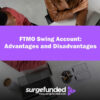Knowing how to optimize your trading strategy for a funded account is essential to success in this environment. A funded account offers traders a special chance to acquire substantial capital without having to risk their own money. This entails knowing how to optimize your trading strategy for a funded account while skillfully controlling dangers. This article provides thorough tactics and best practices on how to optimize your trading strategy for a funded account.
Understanding Funded Accounts
Prop firms offer funded accounts that let traders handle funds provided by the firm. Usually, traders give the firm a portion of their gains in exchange. In addition to achieving profitability, the objective is to follow particular risk management standards established by the funding organization. It is crucial to understand these dynamics in order to create a trading strategy that works.
Clearly Stating Trading Objectives
Setting specific, quantifiable objectives is the first step in knowing how to optimize your trading strategy for a funded account. These objectives ought to include:
- Desired ROI, or Return On Investment: Establish the proportion of profit you hope to make over a given time frame.
- Risk Tolerance: Recognize the level of risk you are prepared to accept in each trade and in general.
- Horizon of Time: Decide whether you want long-term growth or short-term rewards.
- Setting Clear Objectives: Setting clear objectives will help you stay focused and make informed trading decisions, particularly under erratic market conditions.
Selecting a Proper Trading Approach
Your total performance can be greatly impacted by diverse trading styles. Selecting a style that fits your personality, risk tolerance, and time constraints is crucial. Typical trading approaches consist of:
- Day Trading: Day trading is the practice of placing several trades in a single day with an emphasis on transient price changes.
- Swing Trading: Holds holdings for a few days or weeks while capturing short- to medium-term market movements.
- Position Trading: Position trading is a long-term approach in which traders use fundamental analysis to hold positions for weeks, months, or even years.
Choosing the right trading style can improve your ability to stick to your plan and execute transactions efficiently.
Backtesting Your Approach
Backtesting is essential before putting any trading technique into practice in a funded account. In order to assess the efficacy of your plan, you must compare it to historical data. This is how backtesting is done:
- Choose Historical Information: Select historical data that is pertinent to the assets you intend to trade.
- Trade Simulators: Utilize historical data to apply your trading strategy, simulating transactions according to your entry and exit criteria.
- Examine The Findings: By looking at indicators like win rate, average profit per trade, maximum drawdown, and overall profitability, you can evaluate how well your approach is working.
Backtesting helps pinpoint areas for improvement and provide insightful information about how your approach might function in actual market situations.
Constant Modification and Enhancement
Because markets are ever-changing, what works now might not work tomorrow.
As a result, it is crucial to constantly assess and modify your trading approach. The following actions can help you consistently improve your strategy:
- Track Performance: Review your trading performance on a regular basis in relation to your objectives. Determine trends in profitable and unsuccessful trades.
- Modify your Risk Management Strategies: Adjust risk-reward ratios, position sizes, and stop-loss levels in light of performance data.
- Keep Up with Market Conditions: Asset values can be greatly impacted by news releases, market mood, and economic developments. Keep abreast of pertinent news that may have an impact on your transactions.
You may increase profitability and successfully manage risks by being proactive in modifying your plan in response to performance indicators and market conditions.
How to Put Effective Risk Management Into Practice
When using a funded account to trade, risk management is essential. Profitable opportunities are allowed while capital is protected by effective risk management techniques. Important elements consist of:
- Position Sizing: Based on your overall account size and risk tolerance, decide how much money to put into each transaction. If required, make use of position sizing calculators.
- Stop Loss Orders: Stop-loss orders should always be used to reduce possible losses on each trade. By doing this, you may make sure that you don’t go above set loss levels.
- Risk To Reward Ratio: A favorable risk-reward ratio, such as 1:2 or above, indicates that possible gains greatly exceed probable losses.
You can protect the financing firm’s capital while making profitable trades by following strict risk management procedures.
Making Use of Cutting-Edge Tools and Technologies
Using advanced trading tools can greatly improve your capacity to maximize strategies in the setting of a funded account:
- Charting Software: For improved market analysis, use advanced charting platforms with customizable capabilities, trend analysis tools, and technical indicators.
- Automated Trading Systems: To reduce emotional decision-making, think about utilizing algorithmic trading systems or expert advisors (EAs), which execute trades according to predetermined parameters.
- Journals of Trading: To aid in self-evaluation and progress over time, keep a thorough trading journal that records all of your trades, including entry and exit points, decision-making rationales, and feelings felt during trades.
Making use of these resources can improve overall trading efficiency, aid in knowing how to optimize your trading strategy for a funded account and offer insights into market activity.
Maintaining Self-Control and Realism
Maintaining self-control is essential when handling a financed account. Discipline must be maintained because emotional decisions can result in large losses:
- Adhere to Your Trading Strategy: Even at times when the market is volatile, adhere closely to your predetermined trading strategy.
- Have Reasonable Expectations: Recognize that investing involves losses; instead of aiming for big wins every trade, look for steady gains.
- Take Breaks When Necessary: After a string of trades, if you find yourself getting overstimulated or upset, take some time to clear your head before going back to the market.
You can overcome obstacles and maximize success in a funded account environment by developing discipline and reasonable expectations.
Acquiring Knowledge from Errors
Every trader makes mistakes; how you handle them is what counts. Examining unsuccessful trades might teach important lessons that guide future choices:
- Examine Losing Trades: Determine what went wrong: was it a lack of adherence to risk management guidelines, a faulty analysis, or an emotional decision?
- Modify Strategies Appropriately: Make use of the knowledge you acquire from errors to improve your tactics and prevent them from happening again.
- Ask for Input from Mentors or Peers: Speaking with mentors or other traders can help you see your strategy from a variety of angles and pinpoint areas that need work.
You may consistently improve your tactics for greater results in funded accounts by embracing a growth mindset that emphasizes learning from mistakes.
In conclusion
It takes a diverse approach to optimize your trading strategy for a funded account, including goal-setting, style selection, ongoing modification, effective risk management, utilizing cutting-edge tools, discipline, and learning from mistakes. Traders can increase their profitability and successfully manage the risks involved in employing funding firms’ funds by regularly putting these techniques into practice.
In the end, success in funded accounts depends on psychological fortitude and flexibility in reaction to shifting market conditions in addition to technical proficiency. Together with good trading techniques, these traits can help traders reach their full potential and confidently negotiate the intricacies of the financial markets.
Frequently Asked Questions
1. What Are Funded Accounts
- Prop firms offer funded accounts that let traders handle funds provided by the firm. Usually, traders give the firm a portion of their gains in exchange. In addition to achieving profitability, the objective is to follow particular risk management standards established by the funding organization.
2. How To Clearly State Trading Objectives
Setting specific, quantifiable objectives is the first step in knowing how to optimize your trading strategy for a funded account. These objectives ought to include:
- Desired ROI, or Return On Investment: Establish the proportion of profit you hope to make over a given time frame.
- Risk Tolerance: Recognize the level of risk you are prepared to accept in each trade and in general.
- Horizon of Time: Decide whether you want long-term growth or short-term rewards.
- Setting Clear Objectives: Setting clear objectives will help you stay focused and make informed trading decisions, particularly under erratic market conditions.
3. How To Select A Proper Trading Approach
- Day Trading: Day trading is the practice of placing several trades in a single day with an emphasis on transient price changes.
- Swing Trading: Holds holdings for a few days or weeks while capturing short- to medium-term market movements.
- Position Trading: Position trading is a long-term approach in which traders use fundamental analysis to hold positions for weeks, months, or even years.
Choosing the right trading style can improve your ability to stick to your plan and execute transactions efficiently.
4. How To Backtest Your Approach
- Choose Historical Information: Select historical data that is pertinent to the assets you intend to trade.
- Trade Simulators: Utilize historical data to apply your trading strategy, simulating transactions according to your entry and exit criteria.
- Examine The Findings: By looking at indicators like win rate, average profit per trade, maximum drawdown, and overall profitability, you can evaluate how well your approach is working.


















